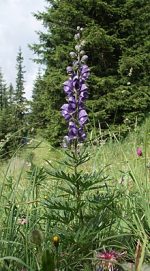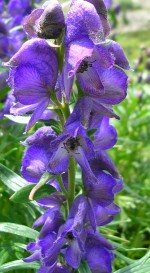
Also called wolfsbane and helmet flower, this herbaceous perennial is a member of the buttercup family, Ranunculaceae, that also includes columbine, hellebore, and delphinium. It is native and endemic to western and central Europe where it grows in moist areas of pastures and mountains. Growing two to four feet tall from a tuberous taproot, the plant has hairless dark green leaves two to four inches across that are so divided that they appear linear. The indigo blue to dark purple flowers are up to an inch long and appear in summer in terminal racemes up to eight inches long. They have an upper sepal that develops into a large helmet that resembles the hood of medieval monks, leading to the common name of monkshood and helmet flower. Plants grow best where nights are cool. A pink flowered cultivar, ‘Caeneum’ is available but fades where evenings are warm. All parts of the plant are poisonous and the common name, wolfsbane, comes from the use of the plant to produce a poison to kill wolves. The derivation of the genus name, Aconitum, is disputed but may come from a Greek word ἀκόνιτον (akoniton) which may come from the Greek word ἀκόν (akon) meaning dart or javelin, the tips of which were dipped in poison. The specific epithet, napellus, is the diminutive of the Latin word, napus, meaning turnip and refers to the appearance of the root system.

Type: Herbaceous perennial
Bloom: Indigo blue to dark purple flowers up to an inch long in terminal racemes up to eight inches long in summer; upper sepal develops into a large helmet
Size: 2-4’ H x 1-1.5’ W
Light: Sun in northern part of range with plenty of water; some shade in southernpart of range with plenty of water
Soil: Fertile, consistently moist, well-drained
Hardiness: Zones 3-7
Care: Cut back after first flowering to encourage second bloom.
Pests and Diseases: Generally healthy but may have problems with crown rot, powdery mildew, or verticillium wilt.
Propagation: Seed; division; planting of offsets
Companion Plants: Sedum ‘Autumn Joy’, black cohaosh (Cimicifuga racemosa), Japanese anemones (Anemone x hybrida), ferns, hostas
Photo Credits Wikipedia